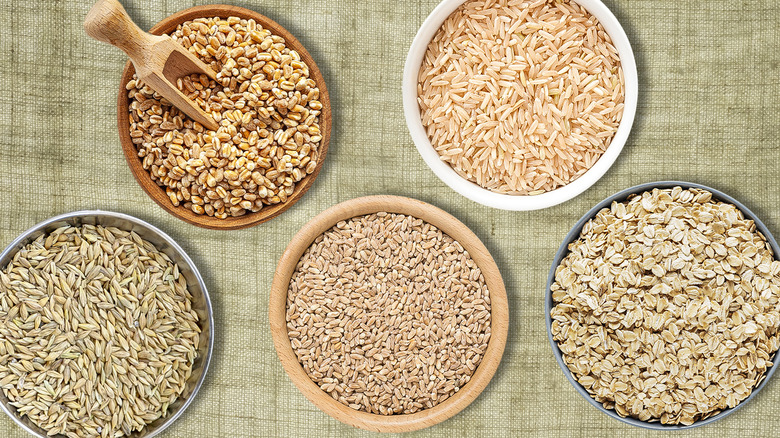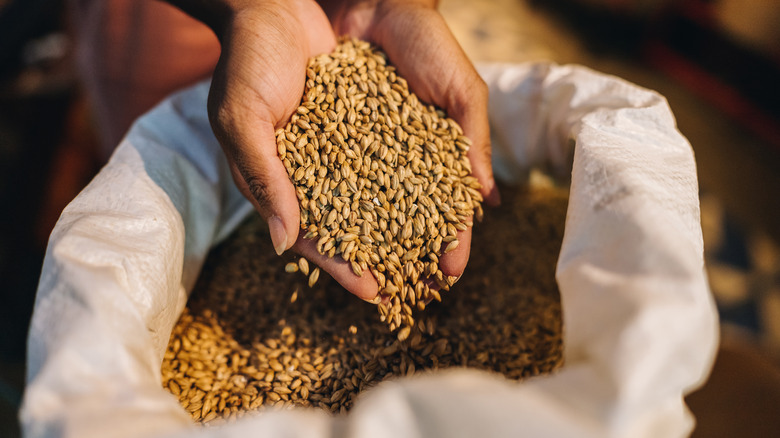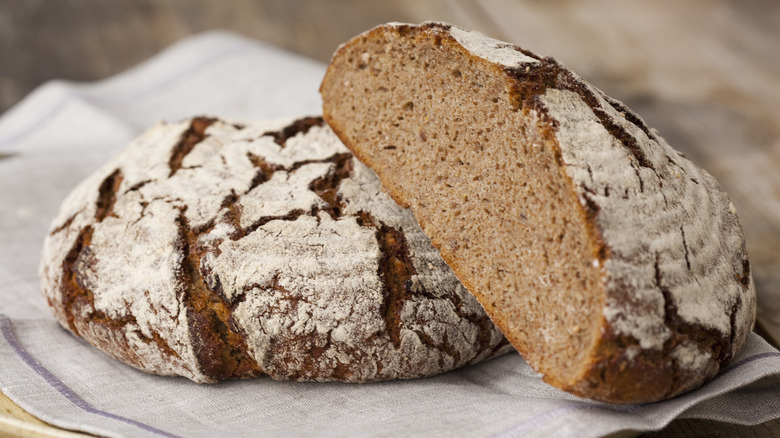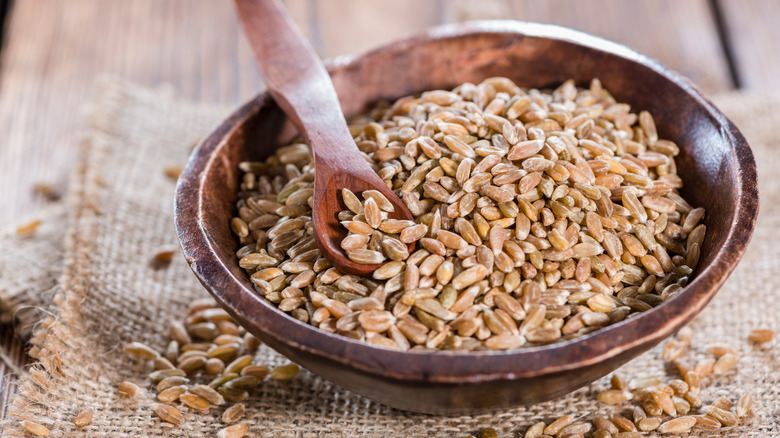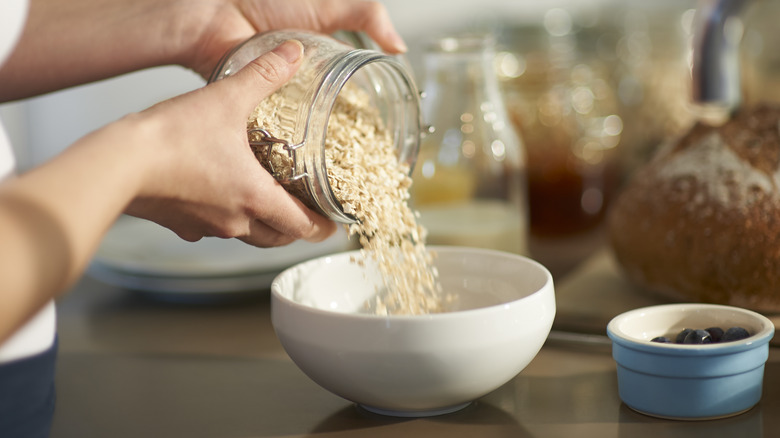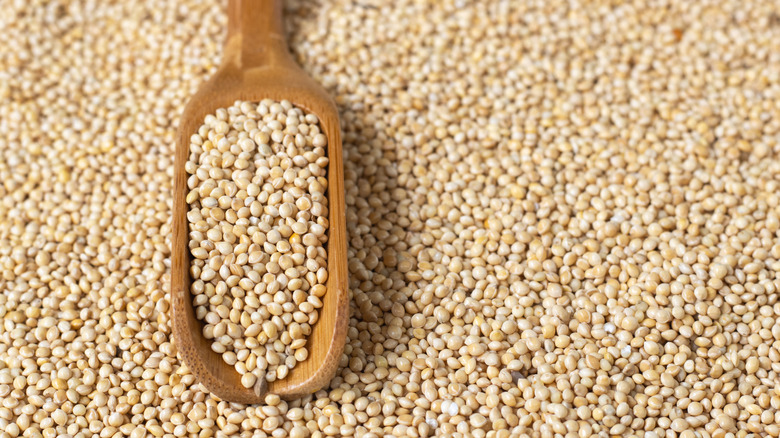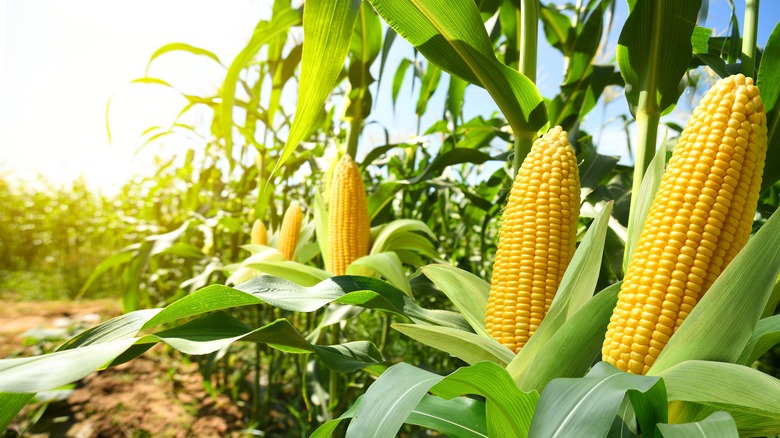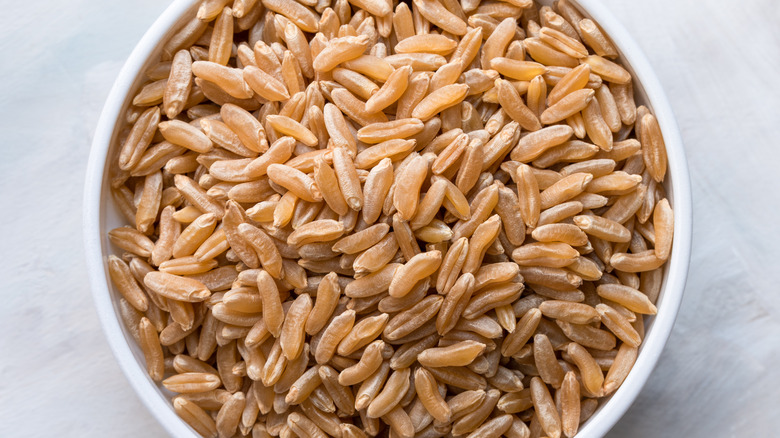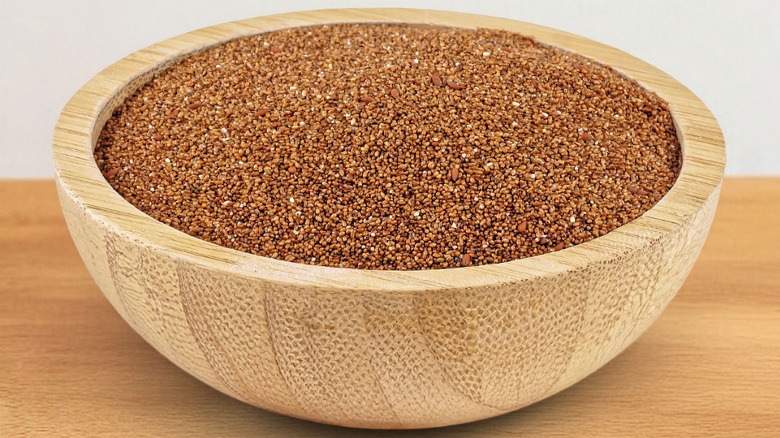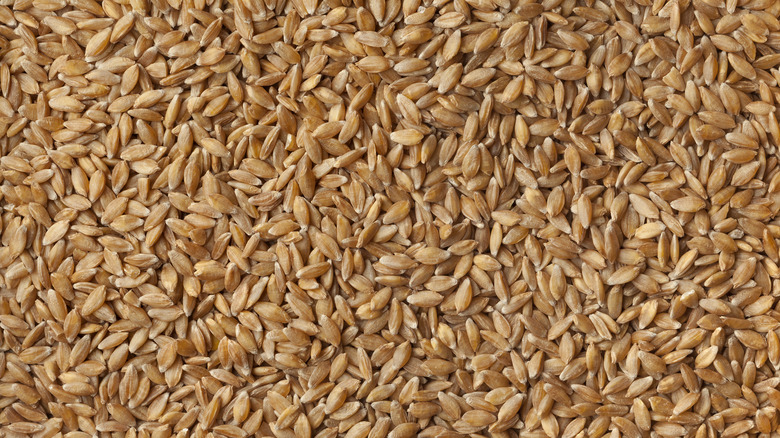12 Types Of Cereals, Explained
A staple in the human diet for thousands of years, cereals serve as an essential food source all over the world. And no, we're not talking about the kind of cereal you'd pour into your breakfast bowl, but rather those versatile starchy grains that are cultivated, harvested, and transformed into a range of foods we enjoy in our day-to-day diets. Whilst different cereal plants share similar qualities, each yields a grain with its own unique flavor, nutritional profile, and specific applications. These hearty ingredients can be used in everything from breads, cakes, and crackers to porridges and soups.
Whilst wheat, barley, and oats are likely a regular feature in your pantry, there are also a range of lesser-known grains, like teff and millet, that can make an equally tasty and nutrient-loaded addition to your diet. So, if you're keen to learn more about these ancient grains, read on. We'll guide you through the types of cereal grains that absolutely deserve a place in your kitchen, covering the distinct qualities of each, exploring their uses, and providing ideas for incorporating them into your meals at home.
1. Wheat
Wheat — it's perhaps the most familiar cereal for many, and in fact, it's the second-most widely grown grain globally. Originating in the Middle East over 10,000 years ago, wheat has fueled civilizations past and present, with its versatility and nutritional benefits securing its staple status. Today, wheat features in a huge range of foodstuffs, which are consumed by a diverse array of cultures.
The parts of the wheat crop that are harvested for consumption are called the kernels, which are essentially the seeds of the plant. These are commonly ground down into flour, such as all-purpose, wholemeal, or bread flours. There are also two main varieties of this crop — hard wheat and soft wheat. Soft wheat has less gluten and protein than hard wheat, so it's best used in baked goods such as cakes and pastries, where a lighter texture is desirable. On the other hand, hard wheat (aka durum wheat) is great for making breads, pastas, and noodles, with its high gluten and protein content producing a firmer, chewier texture.
Nutritionally, wheat is an excellent source of carbohydrates, protein, and B vitamins, especially when consumed as a whole grain, which retains the bran and germ components of the kernel. Whole grain wheat provides essential minerals like magnesium and zinc, offering benefits for muscle health and immunity, as well as being higher in fiber. Refined wheat flour, whilst extremely versatile, does lacks some of these nutrients, as the bran and germ are removed.
2. Barley
Another of the world's oldest cultivated grains, barley is a resilient crop that's grown in various climates. The small kernels it yields offer a distinct, nutty flavor and range of health benefits. This grain is often used to make breads and breakfast cereals, and you'll find it in many sauces and condiments like malt vinegar and Worcestershire sauce. Barley is also used to make malted beverages like beer, since the enzymes it possesses can facilitate fermentation.
A great source of dietary fiber, barley has particularly high levels of a form called beta-glucan, which is known for its ability to help reduce cholesterol levels and maintain steady blood sugar levels. In fact, barley can contain up to 11 times more beta-glucan than wheat. Hulled barley, which retains the bran layer, is considered a whole grain, while pearl barley, which is more commonly found in grocery stores, has had some bran removed, making it less fibrous but still nutritious.
Barley makes an excellent pantry staple and is great for bringing a unique texture and taste to your meals. You can add barley to soups and stews in place of potatoes, use it to make risottos, or even simply as a substitute for rice or pasta.
3. Rye
Rye is a close relative of wheat and barley, but it has an earthy and light malted flavor, which lends itself well to hearty breads, crackers, and even whiskey. This grain is also exceptionally hardy, with rye crops thriving in colder climates — even in the freezing temperatures of the Arctic Circle! Understandably, rye is a staple in Northern European cuisines, and its unique taste has made it famous in breads like pumpernickel, as well as traditional Scandinavian rye breads, which are denser and darker than typical wheat breads.
Consuming rye also comes with plenty of health benefits. This cereal is packed with fiber, especially in its whole grain form. This means that rye products can aid with digestion whilst helping you feel full for longer. Rye is also lower on the glycemic index than other grains like wheat, meaning it won't cause dramatic spikes in blood sugar levels, so it's a popular choice for those managing diabetes.
Making your own rye-based baked goods is easy enough to do at home, and there are a few different types of rye flours to choose from. Light rye flour is made with rye kernels that have had the bran and germ components removed, and it's best for making fluffy breads and muffins. Dark rye flour retains all, or almost all parts of the kernel, offering a richer taste and producing bakes with a denser texture and deeper brown color.
4. Spelt
Next up is spelt, another ancient grain that was thought to be first cultivated around 5000 B.C. And despite being overshadowed by the ever-popular wheat throughout the 20th century, spelt has made a recent comeback in the world of baking. Prized for its wholesome nature, spelt flour is milled using the entire grain, and commonly used in artisan breads and baked goods. It boasts a slightly nuttier and sweeter taste than wheat, whilst also containing more protein.
Spelt is often deemed easier to digest than regular wheat, which is why some people with mild wheat sensitivities prefer it. However, it does contain gluten, so it's not suitable for those with celiac disease. This cereal is also an excellent source of the essential nutrients manganese, phosphorous, and niacin, as well as being higher in antioxidants that wheat. You can use spelt flour in a range of bakes, like breads, muffins, and cookies, where it will result in a tender crumb and rich flavor. Whole spelt berries can also be boiled and used like rice or added to salads and soups, introducing a pleasant chewy texture to any dish.
5. Oats
There's no doubt that oats are a much-loved cereal, commonly enjoyed as a warm breakfast porridge or in the form of granola, cookies, and bars. These little morsels have a hearty texture and mild, creamy flavor, which has made them a staple in many diets. Oats can be blended into smoothies for added sustenance, mixed into cookie doughs, or scattered atop muffins before baking. Oat flour is also fantastic for making healthy, gluten-free pancakes, waffles, and breads.
Not only do oats demonstrate remarkable versatility, but they also bring some impressive health benefits to the table. Like barley, oats are a top source of beta-glucan, a type of soluble fiber linked to reduced blood glucose levels and a healthy gut microbiome. They are also rich in antioxidants, particularly avenanthramides, which have anti-inflammatory properties. And unlike most grains, oats are naturally gluten-free; but they're often processed in facilities with wheat, so individuals with celiac disease should ensure they're eating certified gluten-free oats only.
Steel-cut, rolled, and instant oats are the three main varieties, and each has a slightly different cooking time and texture. Steel-cut oats are the least processed and offer a chewy texture, while rolled oats cook faster due to their flatter shape. Instant oats are the most finely cut variety and have typically been pre-steamed for the longest period of time, making them speedy to prepare.
6. Sorghum
Sorghum may not be an ingredient you typically come across when scanning grocery store labels or gathering your baking ingredients — but it's actually the fifth-most widely grown grain in the world, putting it above both oats and rye! But, what is this mysterious grain? Well, the sorghum plant is actually a type of grass, but it's the small, round, starchy seeds that we harvest for consumption.
In true cereal style, sorghum can be enjoyed in many forms. A great way to use sorghum is in dishes where you might typically reach for rice or quinoa, such as grain bowls or salads. It's also milled into a flour, which makes an effective gluten-free replacement in cakes, cookies, and breads. You can even pop sorghum, just like popcorn, to make a light, crunchy snack.
When it comes to its nutritional profile, sorghum certainly delivers. This grain is packed with antioxidants and fiber, and contains notably high levels of protein, similar to those found in quinoa. Sorghum contains a whole host of essential nutrients like magnesium, iron, and B vitamins, supporting nerve health, red blood cell production, and metabolism. Since it's also gluten-free, it's an excellent way to get your carbohydrates if you're gluten-intolerant or have celiac disease.
7. Millet
The term millet actually refers to a group of cereal grasses from the Poaceae family, with varieties including pearl millet, proso millet, and foxtail millet. Millet plants typically produce small edible seeds, but these can vary in shape and color depending on the particular species.
Like oats and sorghum, millet is natural gluten-free, with a flavor that's sweet and nutty, often likened to that of corn. A staple in diets across parts of Africa, Asia, and Eastern Europe, this cereal is typically prepared in a similar way to rice or quinoa, requiring about 20 minutes of boiling to make it soft and fluffy. Millet can be used as a base for grain bowls, porridges, salads, or even to make a batch of crispy millet fritters.
Whilst you can rely on millet to give you a healthy dose of carbohydrates, protein, and fiber, eating it is also a great way to boost your intake of phosphorous — a mineral that's essential for maintaining healthy bones. Plus, a particular variety of this grain, called finger millet, actually contains more calcium that any other cereal grain, with a cooked cupful providing 13% of your daily recommended intake. Consuming finger millet will provide you with all nine of the essential amino acids, too, helping your body to carry out vital processes like nutrient absorption and tissue growth.
8. Maize/corn
Taking the top spot as the most-produced grain in the world, corn (also known as maize) is perhaps also the most versatile of all the cereals. It has global popularity, particularly across the Americas, and forms the basis of many of our favorite meals, snacks, and ingredients. You've likely come across this humble cereal in countless forms, from the fresh yellow kernels that can be added to soups, salads, and salsas to cornmeal that's perfect for making breads and pancakes. Corn starch, which commonly serves as a thickener for sauces and gravies, also comes from the corn grain. And of course, there's the beloved popcorn — the product of heating corn kernels until they expand and puff up into that delightfully crunchy snack.
The three main varieties of corn are sweet corn, dent corn, and flint corn. Sweet corn is the kind you'd typically eat straight from the cob, whilst dent corn is starchier and better for grinding into flours. Flint corn is tougher still, and often used to make popcorn and polenta.
To make masa and hominy, two popular Mexican staples, dent corn kernels are dried before soaking them in an alkali lime solution. For masa, the soaked corn is then ground into a powder that can be mixed with water to create tortilla and tamale dough. To make hominy, the tough outer hulls of the soaked corn are removed, revealing the white inner kernel. These become wonderfully puffy and chewy when cooked.
9. Rice
Rice is a cereal grain that we know and love, being a staple food for about half of the world's population. It's a prominent feature in Asian and Middle Eastern cuisine, and available in various varieties, including white, brown, basmati, and jasmine. Rice is grown in a rather unique way, with the seedlings requiring continuous submersion in several inches of water as they develop into a tall grass. It's the seeds of this grass that we then harvest and dry for eating.
Each type of rice offers its own unique texture and flavor, from the fluffy and mild white rice to the chewier, nuttier brown rice. Short grain varieties, such as arborio or sushi rice, have a greater starch content, which gives them a stickier texture perfect for whipping up creamy risottos or making compact sushi rolls. All rice is naturally gluten-free, and whole grain varieties are especially high in fiber and antioxidants. Though white rice is less fibrous, it's often enriched by manufacturers to add nutrients back in.
Rice can serve as a base for countless dishes, providing a healthy, convenient, and economical source of carbohydrates. It's often transformed into other forms, too, such as breakfast cereals, rice cakes, pastas, and noodles.
10. Kamut
Kamut, also known as Khorasan wheat, is a grain that's believed to have originated in ancient Egypt. Its large, chewy kernels have a rich and buttery flavor, which makes it a unique addition to various recipes. Kamut is a member of the wheat family, and its cultivation methods have remained the same for hundreds of years. This means it hasn't been hybridized or modified like many other grains. Though this cereal is not gluten-free, many people who experience unwanted gastrointestinal symptoms when consuming wheat report that Kamut is far easier to digest. Additionally, enjoying Kamut provides an array of vitamins and minerals, including selenium, zinc, and magnesium. This grain is also a great option if you're looking to boost protein intake through plant-based sources, since it contains an impressive 10 grams per cooked cup.
Kamut can be used in salads, soups, pilafs, and breads. To achieve a tender texture, it requires rinsing and soaking before a lengthy boiling time of sometimes over an hour. But with its hearty texture, unique taste, and nutritional benefits, the extra prep time is certainly worth the effort!
11. Teff
A tiny, yet nutrient-dense grain native to Ethiopia and Eritrea, teff has a distinctly nutty flavor that can fit into a range of sweet and savory dishes. Teff seeds are significantly smaller than those from many other cereals like wheat and barley, with a typical diameter of less than one millimeter. Because of this, they are particularly difficult to harvest, which makes them slightly pricier than other grains.
However, teff continues to grow in popularity, being naturally gluten-free and highly nutritious. This grain is higher in protein than most other cereals, containing a similar amount to Kamut, and all nine of the essential amino acids. It also has notable levels of calcium and iron, as well as a good dose of gut-friendly fiber.
Teff is a staple in Ethiopian cooking, where it's used to make a type of fermented flatbread called injera. You can also use it as an oatmeal substitute, add it to baked goods, or use it to bulk out burgers and meatballs. Its small size allows it to cook relatively quickly, though this will depend on the type of dish you're making. If you're baking, you can generally use teff flour to replace some of the all-purpose flour in your recipes to add extra flavor and nutrients.
12. Einkorn
Considered the world's oldest form of wheat, einkorn is a unique cereal that's sometimes tricky to source. Its name translates to "single grain" in German, since each spikelet on the plant contains just one kernel.
In comparison to traditional wheat, einkorn tends to be much higher in nutrients, boasting quadruple the levels of vitamin A. This cereal also contains plenty of antioxidants, like lutein and zeaxanthin, which are thought to protect against eye conditions like cataracts and macular degeneration. People with sensitivities to standard wheat often find einkorn easier to digest, since it contains a slightly different form of gluten.
Einkorn might not be available to purchase at your local store, but you should be able to get hold of it from online wholefood stores and other specialty retailers. Like traditional wheat, it's most commonly added to recipes in the form of a finely milled flour, with its flavor being described as a slightly nuttier, toastier take on traditional wheat. You can use einkorn flour to make a rustic homemade loaf of bread, though you may find that your recipe requires less liquid than usual. However, if you're making pancakes, waffles, or quick breads, use the einkorn flour just as you would standard wheat flour.
